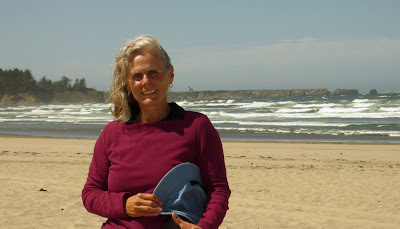 Local colour
Local colour A Gathering Place for Feminine Mariners?
A Gathering Place for Feminine Mariners?The first day we caught up on our sleep and worked on the boat. I painted the side decks to match the carriage roof and Doug changed the engine oil. The second day we decided to go for a hike and walked through the Oregon University campus of the Oregon Institute of Marine Biology, up a steep windy gravel road to view the Bar from the Coast Guard lookout station.
 Doug at the Coast Guard Lookout
Doug at the Coast Guard Lookout Coos Bay Bar
Coos Bay Bar Barge Crossing the Coos Bay Bar
Barge Crossing the Coos Bay BarWe continued on to Bastendorff Beach Park where we had a picnic lunch and watched the rollers come in.
 Bastendorff Beach, Oregon (lighthouse in background)
Bastendorff Beach, Oregon (lighthouse in background)We enjoyed stretching our legs and enjoying this off-the-beaten-track countryside. We would have gone farther, as there was a lot more to see at the end of the Cape Arago Highway, including a state park, the lighthouse, adventure trails and spectacular scenery.
 Cape Arago
Cape AragoFrom my diary: Day before yesterday we went for a long walk around the point to an absolutely gorgeous out-of-the-way beach. It was quite a windy day, with the ocean rollers crashing in and people surfing. The flora is an interesting mix of what we are used to on Vancouver Island, like Oregon grape and salal, mixed in with what you would see in Northern California, like sage.
I’ve been reading about the history of this area and, like any place else on the coast, it was central for a large, thriving native population. Unfortunately they were pretty much decimated by smallpox when the white settlers started showing up. The whites weren’t particularly nice to them at all and quickly exploited the area for lumber, fishing, agriculture and other industry, ignoring the rights of the Indians. That was about 1853. Although the place has evolved over time, it really hasn’t changed much. According to the census data it has a homogeneous population, with few people of a different colour or culture. Only .2% of the population is native. I am amazed by just how many small fishing boats are still operating here – ones that have obviously been in families for generations.
Next day we headed into the village of Charleston to visit Englund Marine. While Doug was shopping for boat bits, I browsed in the Charleytown Market Place. I must admit, on first look I thought this might be a tickytacky tourist gift shop, but I learned, once again, never to judge a book by its cover. It was a charming place full of the most amazing assortment of local crafts and artwork, antiques, gifts, local preserves, wine and candy, jewelry, fibre arts and greeting cards. Doug had to come rescue me and, even then, I had found birthday presents for three of my family and a selection of writing cards for myself. Doug chose some Oregon cherry and wild blackberry jam. If we weren’t on a sailboat, I would have bought a lot more. It was a fascinating place to browse and the lady who owns it was a wealth of information. (http://www.charleytownmarketplace.com)

Funky cottage at CharleyMarket
 Works for me!
Works for me!Unfortunately, Charleston does not have a grocery store, so the next day we made a trip into Coos Bay, the larger centre, to forage for provisions. This turned out to be interesting as well. For under 5 dollars, Doug and I rode a small bus all through the Coos Bay area. This inexpensive tour took us through many neighbourhoods and we got the chance to see how people lived in this area. Many of the houses we passed were small and neat – not a monster house in sight. Coos Bay is a working town.
Another day we went to the annual Seafood Festival, a modest celebration of life by the sea. We enjoyed some tuna tacos, barbequed Coos Bay oysters and some slow smoked ribs. Later in the day we bought a couple crabs at the end of the dock from a fishmonger and had them cook them up for us. Mmmmmm. Doug wanted French bread with his crab (of course), but there were no bakeries nearby. Instead, I made some bannock which also turned out well. I regret I didn’t bring a lot more of our Canadian flour. I remember just how special it is from importing it to make bread in Hong Kong. I can see myself baking a lot of quickbreads in our future as they are good and easy to make. My gimbaled Force 10 propane range and oven is a miracle and we depend on it to make our lives more comfortable. Doug bought a loin of albacore tuna for 14 dollars – we got about 10 small steaks out of it – and it looks absolutely amazing. I’ve been looking up recipes on the Internet and tonight we will have some of the steaks marinated in teriyaki on the barbeque. Of course, all this wonderful food goes extremely well with Alaskan Amber, another American favourite.
 Ka'sala's Galley
Ka'sala's Galley+of+alaskan-amber%5B1%5D.jpg)
The only other cruiser we met was another Canadian couple, Anita and Jay, aboard Karina C, a Spencer 35. They are gunkholing their way down to Mexico. Jay lent Doug his oil extractor, so I made an orange loaf from my Muffins and More cookbook and shared it with them. They also have a blog and you can follow their adventures at: http://www.sailblogs.com/member/jabigland.
 Karina C
Karina C At the end of the five days we were raring to go again and the forecast looked good. We cast off about 8am and headed out to sea with the hope that we would make it all the way to San Francisco. It was not to be.

No comments:
Post a Comment